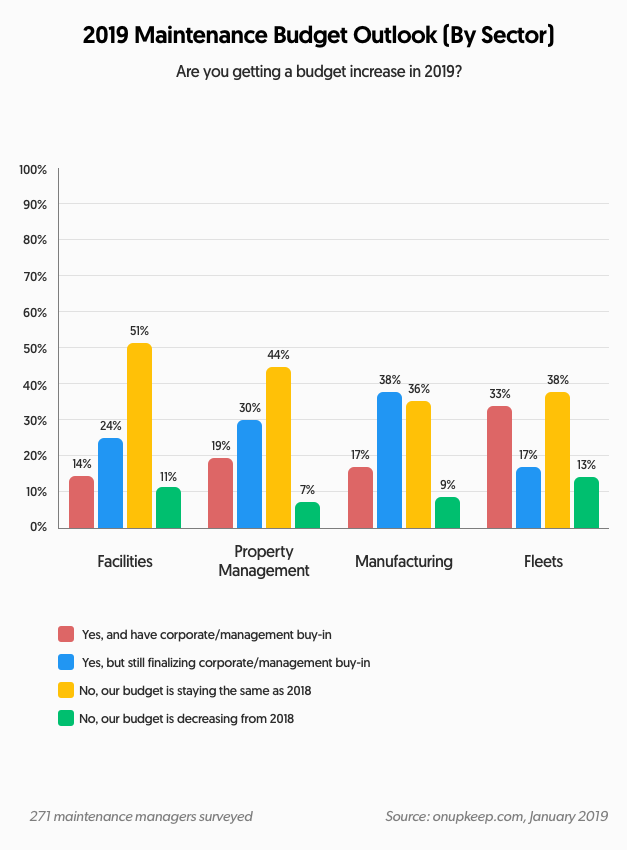by Brianna Crandall — March 1, 2019 — UpKeep Maintenance Management, a provider of simplified CMMS software, just published the results from its 2019 Maintenance Insights Survey.
To understand the current state of maintenance inside organizations, UpKeep surveyed 271 maintenance managers from the areas of manufacturing, facilities management (FM), property management, and fleet management, with various team sizes, about their processes, budget and approach for executing and tracking maintenance activities.
The survey results are segmented into three different topic areas: CMMS adoption, planned maintenance, and maintenance operations. Highlights appear below, and a detailed report is available for each topic area.
CMMS Adoption
Computerized maintenance management system (CMMS) software is the most-used system for tracking maintenance activity, with a 39% adoption rate, followed by spreadsheets (28%) and pen and paper (21%).
Of the different systems used, small maintenance teams use pen and paper the most, medium-size teams use spreadsheets the most, and large terms use CMMS software the most.
When CMMS users were asked why they use a CMMS, an overwhelming majority said for organization (75%). Runners-up were related to cost savings (increase profits) and productivity (wrench time).
Other insights include:
- Only 52% of maintenance teams have technicians that update work orders in the field with a mobile CMMS app. The rest either do so from a desktop computer (38%) or don’t update them at all (10%).
- The majority of maintenance managers find it either somewhat challenging (34%), challenging (17%), or very challenging (10%) to get their team to adopt new software and processes. Others find it either easy (25%) or very easy (14%).
Planned Maintenance
Planned maintenance is seen as the most important key performance indicator (KPI) for 54% of maintenance managers, followed by uptime (30%) and wrench time (16%).
Of maintenance managers who say planned maintenance is the most important KPI, only about two out of five say more than half of their work is scheduled. The other three say either less than half of work is scheduled, very little, or none at all.
Less than half of teams that use a CMMS schedule all their preventive maintenance tasks in it. Other teams that use a CMMS either schedule some of them, none of them, or don’t perform preventive maintenance.
Medium-sized teams with 11 to 20 technicians are the least likely to schedule all PMs in their CMMS. Large teams with 50+ technicians are the most likely.
Maintenance Operations
Maintenance managers at manufacturing plants are the most likely to receive a budget increase in 2019, while facilities managers (FMs) are the least likely.
Teams that are not using any system to track their maintenance activity are the least confident in their ability to make ROI (return-on-investment) cases for extra budget, while those using a CMMS are the most confident.
Other insights:
- 46% of maintenance managers don’t think a recession would impact their maintenance operations, and 20% don’t think a recession will even happen.
- Managers that have the procurement department interact with their CMMS (23%) are the most likely to get a budget increase in 2019 (64%).
- The majority of maintenance managers are satisfied with their maintenance budget (58%), and an overwhelming majority are confident in their ability to retain good technicians (80%).
- When asked about the different ways maintenance managers retain talent, 73% said through staying organized and setting clear expectations. 53% said through providing safe working conditions. Runners-up were paying above-average wages (33%), focusing on high-level metrics rather than wrench time (27%), and providing reimbursement for training and further education (24%).
Methodology
271 maintenance professionals (manager level and above) who use the free or paid version of UpKeep responded to this survey. Respondents were in one of four industries: manufacturing, facility management, property management, or fleet management. Responses were largely based in North America (US and Canada), but did include international responses as well.
For more details and graphs on the CMMS Adoption, Planned Maintenance and Maintenance Operations aspects of the survey results, visit the UpKeep website.







